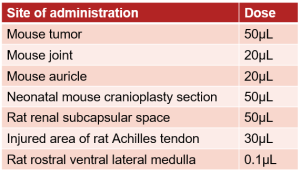Show Q&A menu
AteloGene® Local Use “Quick Gelation”/ Local Use
Is it possible to use higher concentrations of siRNA/miRNA than the recommended amount?
Several articles have shown dose-dependent effects but there are no reports of problems encountered by using concentrations of siRNA/miRNA higher than the recommended concentration.
Can I store a mixture of AteloGene® and siRNA/miRNA?
We recommend preparing the mixture at the time of use. It is possible to prepare the mix on a small scale if you need a small quantity. Please ask us for details.
Has AteloGene® Local Use/Local Use Quick Gelation been locally administered at volumes lower than the recommended 200 µL?
The following table lists some tissue-specific applications and the recommended doses of the solution.

It is recommended to prepare the solution such that the amount of nucleic acid per administration site is the same as our recommendation (0.5– 1 nmol/site).
Can I use AteloGene® in animals other than mice, for example, rats and rabbits?
Although the recommended dose of AteloGene® is specifically for mice, it has been used for rats and rabbits by adjusting the dose appropriately for the tissue size of the animal.
Has AteloGene® Local Use/Local Use Quick Gelation been locally injected into rats?
It has been locally injected in models of subcutaneous tumors, diabetes, and peripheral neuropathy.
What types of nucleic acids have been used in AteloGene Local Use?
Various nucleic acids such as siRNA, shRNA, miRNA, miRNA inhibitor, locked nucleic acid, antisense oligos, single-stranded oligonucleotides, and plasmid DNA have been used with AteloGene Local Use. The main component of AteloGene, atelocollagen, is positively charged and therefore, binds anionic nucleic acids to form complexes.
What is the longest nucleic acid that has been used with AteloGene® Local Use/Local Use Quick Gelation?
AteloGene® Local Use/Local Use Quick Gelation has been used with plasmid vectors up to 10 kbp in length.
How long do the effects of siRNA/miRNA last?
Approximately a week following local administration.
How long does AteloGene® remain at the site of injection?
It will degrade after approximately a week, depending on the injection site, after local administration.
Can I inject a mixture of AteloGene® and siRNA/miRNA into a xenograft tumour?
We recommend covering the tumour with AteloGene® to avoid damage from injection. However, there are many articles describing the use of intra-tumoural injections.
Is AteloGene® applicable for use in in vitro experiments?
AteloGene® is designed for in vivo experiments only. Please use AteloGene® for your in vivo experiments following in vitro evaluation of siRNA/miRNA.
Information on this page is based on published articles and in-house data.